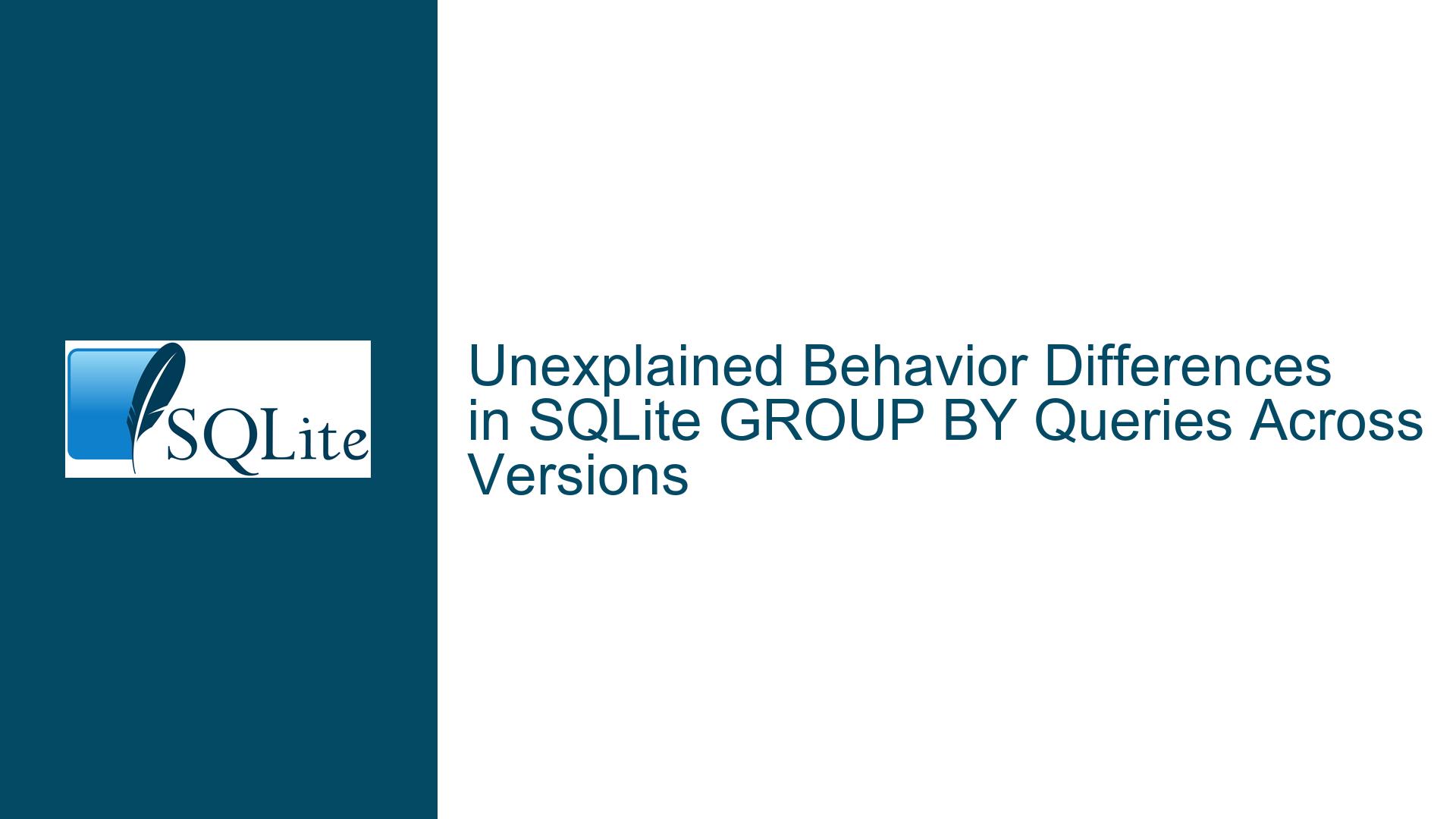Unexplained Behavior Differences in SQLite GROUP BY Queries Across Versions
SQLite GROUP BY Query Behavior Changes Between Versions 3.19.3 and 3.31.1
The behavior of SQLite’s GROUP BY clause has evolved over time, particularly in how it handles non-aggregated columns that are not explicitly included in the GROUP BY list. This evolution has led to differences in query results between SQLite versions 3.19.3 and 3.31.1, which can cause confusion and unexpected behavior in applications that rely on specific query outcomes. The core issue revolves around how SQLite selects rows when non-aggregated columns are included in the SELECT clause of a GROUP BY query. In version 3.19.3, the query appears to return the last row in each group, while in version 3.31.1, it returns the first row. This discrepancy is not a bug but rather a result of SQLite’s implementation details and its leniency in handling non-standard SQL queries.
To understand the issue fully, consider a table named Weird with the following schema and data:
CREATE TABLE Weird (
id INTEGER PRIMARY KEY,
ident TEXT NOT NULL,
name TEXT NOT NULL,
insert_time DATETIME DEFAULT CURRENT_TIMESTAMP
);
INSERT INTO Weird(ident,name) VALUES("World","Huey");
INSERT INTO Weird(ident,name) VALUES("World","Dewey");
INSERT INTO Weird(ident,name) VALUES("World","Louie");
INSERT INTO Weird(ident,name) VALUES("Hello","Mickey");
INSERT INTO Weird(ident,name) VALUES("Hello","Goofy");
INSERT INTO Weird(ident,name) VALUES("Hello","Minnie");
When the following query is executed:
SELECT ident, name, insert_time FROM Weird GROUP BY ident;
The results differ between SQLite versions 3.19.3 and 3.31.1. In version 3.19.3, the query returns the last row for each ident group:
[(u'Hello', u'Minnie', u'2020-04-11 04:53:57'), (u'World', u'Louie', u'2020-04-11 04:53:57')]
In version 3.31.1, the query returns the first row for each ident group:
[('Hello', 'Mickey', '2020-04-11 04:53:56'), ('World', 'Huey', '2020-04-11 04:53:56')]
This difference in behavior is not documented as a breaking change in SQLite’s release notes, which can lead to confusion for developers who rely on consistent query results across versions.
SQLite’s Leniency with Non-Aggregated Columns in GROUP BY Queries
The root cause of the behavior difference lies in SQLite’s handling of non-aggregated columns in GROUP BY queries. According to the SQL standard, any column in the SELECT clause of a GROUP BY query must either be part of the GROUP BY list or be wrapped in an aggregate function. However, SQLite allows non-aggregated columns to be included in the SELECT clause without being part of the GROUP BY list or an aggregate function. This is a deliberate design choice in SQLite, documented as a "quirk" in its official documentation.
When a non-aggregated column is included in the SELECT clause of a GROUP BY query, SQLite selects a value from one of the rows in the group. The specific row chosen is not guaranteed and is considered an implementation detail. In earlier versions of SQLite, such as 3.19.3, the implementation detail favored selecting the last row in the group. In later versions, such as 3.31.1, the implementation detail shifted to selecting the first row in the group. This change was not explicitly documented as a breaking change, leading to unexpected behavior for users who relied on the older behavior.
The leniency of SQLite in handling non-aggregated columns can be both a blessing and a curse. On one hand, it allows for more flexible querying, especially in scenarios where the exact row selected is not critical. On the other hand, it can lead to non-portable queries that behave differently across SQLite versions or other database systems. For example, most other relational database management systems (RDBMS) would reject the query outright, returning an error indicating that the non-aggregated column must be either grouped or aggregated.
To illustrate the issue further, consider the following query:
SELECT ident, name, max(insert_time) FROM Weird GROUP BY ident;
In this query, max(insert_time) is an aggregate function, ensuring that the insert_time column is properly aggregated. However, the name column is neither grouped nor aggregated. SQLite handles this by selecting the name value from the row that contains the max(insert_time) for each group. This behavior is guaranteed by SQLite as an implementation detail, but it is not portable to other database systems.
Ensuring Consistent Query Results Across SQLite Versions
To ensure consistent query results across different SQLite versions, developers must avoid relying on implementation details such as the selection of non-aggregated columns in GROUP BY queries. Instead, they should explicitly specify the desired behavior using standard SQL constructs. One approach is to use subqueries to isolate the rows of interest before performing the GROUP BY operation.
For example, to retrieve the row with the latest insert_time for each ident group, the following query can be used:
SELECT ident, name, insert_time
FROM Weird a
WHERE insert_time = (
SELECT MAX(insert_time)
FROM Weird b
WHERE a.ident = b.ident
);
This query uses a subquery to find the maximum insert_time for each ident group and then selects the corresponding row from the Weird table. This approach is both portable and guaranteed to return consistent results across SQLite versions.
Another approach is to use window functions, which are supported in SQLite starting from version 3.25.0. Window functions allow for more sophisticated querying and can be used to achieve the same result as the subquery approach:
SELECT ident, name, insert_time
FROM (
SELECT ident, name, insert_time,
ROW_NUMBER() OVER (PARTITION BY ident ORDER BY insert_time DESC) AS rn
FROM Weird
)
WHERE rn = 1;
In this query, the ROW_NUMBER() window function is used to assign a unique number to each row within its ident group, ordered by insert_time in descending order. The outer query then selects the row with rn = 1, which corresponds to the row with the latest insert_time for each ident group.
By using these techniques, developers can ensure that their queries are both portable and consistent across different SQLite versions. Additionally, they should always test their queries against the specific versions of SQLite that their applications will be using, to avoid any unexpected behavior due to implementation details or changes in the database engine.
In conclusion, the difference in behavior between SQLite versions 3.19.3 and 3.31.1 when handling non-aggregated columns in GROUP BY queries is a result of SQLite’s leniency and implementation details. To avoid issues, developers should avoid relying on these implementation details and instead use standard SQL constructs such as subqueries or window functions to achieve consistent and portable query results.






